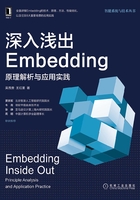
2.3 从预训练模型获取Embedding
在自然语言处理中,构建大规模的标注数据集非常困难,以至于仅用当前语料无法有效完成特定任务。面对这种情况该怎么办呢?可以采用迁移学习的方法,即将预训练好的词嵌入作为模型的权重,然后在此基础上微调。下面就用一个简单实例来讲解如何使用预训练的词嵌入提升模型性能。
2.3.1 背景说明
本节基于数据集IMDB进行情感分析,做预测之前需要先对数据集进行预处理,把词转换为词嵌入。这里我们采用迁移学习的方法来提升模型的性能,并使用2014年英文维基百科的预计算词嵌入数据集。该数据集文件名为glove.6B.zip,大小为822MB,里面包含400000个单词的100维嵌入向量。把预训练好的词嵌入导入模型的第一层,并冻结该层,然后增加分类层进行分类预测。GloVe词嵌入数据集的下载地址为https://nlp.stanford.edu/projects/glove/。
2.3.2 下载IMDB数据集
下载IMDB数据集并保存在本地。这里我们已经下载并保存好了,目录为./aclImdb。
import os
imdb_dir = './aclImdb'
train_dir = os.path.join(imdb_dir, 'train')
labels = []
texts = []
for label_type in ['neg', 'pos']:
dir_name = os.path.join(train_dir, label_type)
for fname in os.listdir(dir_name):
if fname[-4:] == '.txt':
f = open(os.path.join(dir_name, fname))
texts.append(f.read())
f.close()
if label_type == 'neg':
labels.append(0)
else:
labels.append(1)
2.3.3 进行分词
利用TensorFlow 2.0提供的Tokenizer函数进行分词操作,如下所示。
from tensorflow.keras.preprocessing.text import Tokenizer
from tensorflow.keras.preprocessing.sequence import pad_sequences
import numpy as np
maxlen = 100 # 只保留前100个单词的评论
training_samples = 200 # 在200个样本上训练
validation_samples = 10000 # 对10000个样品进行验证
max_words = 10000 # 只考虑数据集中最常见的10000 个单词
tokenizer = Tokenizer(num_words=max_words)
tokenizer.fit_on_texts(texts)
sequences = tokenizer.texts_to_sequences(texts)
word_index = tokenizer.word_index
print('Found %s unique tokens.' % len(word_index))
data = pad_sequences(sequences, maxlen=maxlen)
labels = np.asarray(labels)
print('Shape of data tensor:', data.shape)
print('Shape of label tensor:', labels.shape)
# 将数据划分为训练集和验证集
# 首先打乱数据, 因为一开始数据集是排好序的
# 负面评论在前, 正面评论在后
indices = np.arange(data.shape[0])
np.random.shuffle(indices)
data = data[indices]
labels = labels[indices]
x_train = data[:training_samples]
y_train = labels[:training_samples]
x_val = data[training_samples: training_samples + validation_samples]
y_val = labels[training_samples: training_samples + validation_samples]
运行结果如下:
Found 88582 unique tokens. Shape of data tensor: (25000, 100) Shape of label tensor: (25000,)
2.3.4 下载并预处理GloVe词嵌入
前文对GloVe词嵌入进行了简单介绍,这里主要讲解如何下载并预处理GloVe词嵌入。
1)对glove.6B.100d.txt进行解析,构建一个由单词映射为其向量表示的索引。glove.6B数据集比较大,下载会需要一些时间。这里我们已下载并放在了本地目录中。
glove_dir = './glove.6B/'
embeddings_index = {}
f = open(os.path.join(glove_dir, 'glove.6B.100d.txt'))
for line in f:
values = line.split()
word = values[0]
coefs = np.asarray(values[1:], dtype='float32')
embeddings_index[word] = coefs
f.close()
print('Found %s word vectors.' % len(embeddings_index))
2)查看字典的样例:
for key,value in embeddings_index.items():
print(key,value)
print(value.shape)
break
运行结果如下:
the [-0.038194 -0.24487 0.72812 -0.39961 0.083172 0.043953 -0.39141
0.3344 -0.57545 0.087459 0.28787 -0.06731 0.30906 -0.26384
-0.13231 -0.20757 0.33395 -0.33848 -0.31743 -0.48336 0.1464
-0.37304 0.34577 0.052041 0.44946 -0.46971 0.02628 -0.54155
-0.15518 -0.14107 -0.039722 0.28277 0.14393 0.23464 -0.31021
0.086173 0.20397 0.52624 0.17164 -0.082378 -0.71787 -0.41531
0.20335 -0.12763 0.41367 0.55187 0.57908 -0.33477 -0.36559
-0.54857 -0.062892 0.26584 0.30205 0.99775 -0.80481 -3.0243
0.01254 -0.36942 2.2167 0.72201 -0.24978 0.92136 0.034514
0.46745 1.1079 -0.19358 -0.074575 0.23353 -0.052062 -0.22044
0.057162 -0.15806 -0.30798 -0.41625 0.37972 0.15006 -0.53212
-0.2055 -1.2526 0.071624 0.70565 0.49744 -0.42063 0.26148
-1.538 -0.30223 -0.073438 -0.28312 0.37104 -0.25217 0.016215
-0.017099 -0.38984 0.87424 -0.72569 -0.51058 -0.52028 -0.1459
0.8278 0.27062 ]
(100,)
3)在embeddings_index字典的基础上构建一个矩阵,其形状为10000×100。对单词索引(word_index)中索引为i的单词来说,该矩阵(embedding_matrix)的元素i就是这个单词对应的词向量(其维度为embedding_dim,即100)。
embedding_dim = 100
embedding_matrix = np.zeros((max_words, embedding_dim))
for word, i in word_index.items():
embedding_vector = embeddings_index.get(word)
if i < max_words:
if embedding_vector is not None:
# 在嵌入索引(embedding index)找不到的词,其嵌入向量都设为0
embedding_matrix[i] = embedding_vector
2.3.5 构建模型
采用Keras的序列(Sequential)构建模型,代码如下:
from tensorflow.keras.models import Sequential from tensorflow.keras.layers import Embedding, Flatten, Dense model = Sequential() model.add(Embedding(max_words, embedding_dim, input_length=maxlen)) model.add(Flatten()) model.add(Dense(32, activation='relu')) model.add(Dense(1, activation='sigmoid')) model.summary()
运行结果如下:
Model: "sequential" _________________________________________________________________ Layer (type) Output Shape Param # ================================================================= embedding (Embedding) (None, 100, 100) 1000000 _________________________________________________________________ flatten (Flatten) (None, 10000) 0 _________________________________________________________________ dense (Dense) (None, 32) 320032 _________________________________________________________________ dense_1 (Dense) (None, 1) 33 ================================================================= Total params: 1,320,065 Trainable params: 1,320,065 Non-trainable params: 0
在模型中加载GloVe词嵌入,并冻结Embedding Layer。
model.layers[0].set_weights([embedding_matrix]) model.layers[0].trainable = False
2.3.6 训练模型
这里,我们设置训练批次大小为32,共迭代10次,代码如下:
model.compile(optimizer='rmsprop',
loss='binary_crossentropy',
metrics=['acc'])
history = model.fit(x_train, y_train,
epochs=10,
batch_size=32,
validation_data=(x_val, y_val))
model.save_weights('pre_trained_glove_model.h5')
2.3.7 可视化训练结果
进行可视化训练,并查看验证集的准确率(acc),代码如下:
import matplotlib.pyplot as plt
%matplotlib inline
acc = history.history['acc']
val_acc = history.history['val_acc']
loss = history.history['loss']
val_loss = history.history['val_loss']
epochs = range(1, len(acc) + 1)
plt.plot(epochs, acc, 'bo', label='Training acc')
plt.plot(epochs, val_acc, 'b', label='Validation acc')
plt.title('Training and validation accuracy')
plt.legend()
运行结果如图2-2所示。

图2-2 可视化训练结果
从图2-2可以看出,训练准确率与验证准确率相差较大,不过这里只使用了较少的训练数据,但验证准确率达到60%左右,说明效果还不错。
2.3.8 不使用预训练词嵌入的情况
如果不使用预训练词嵌入,则训练过程如下所示。
1)以直接使用训练数据训练模型为例,具体代码如下:
from tensorflow.keras.models import Sequential from tensorflow.keras.layers import Embedding, Flatten, Dense model = Sequential() model.add(Embedding(max_words, embedding_dim, input_length=maxlen)) model.add(Flatten()) #也可以替换为model.add(GlobalMaxPool1D()) model.add(Dense(32, activation='relu')) model.add(Dense(1, activation='sigmoid')) model.summary() model.compile(optimizer='rmsprop', loss='binary_crossentropy', metrics=['acc']) history = model.fit(x_train, y_train, epochs=10, batch_size=32, validation_data=(x_val, y_val))
2)进行可视化训练:
acc = history.history['acc']
val_acc = history.history['val_acc']
loss = history.history['loss']
val_loss = history.history['val_loss']
epochs = range(1, len(acc) + 1)
plt.plot(epochs, acc, 'bo', label='Training acc')
plt.plot(epochs, val_acc, 'b', label='Validation acc')
plt.title('Training and validation accuracy')
plt.legend()
运行结果如图2-3所示。

图2-3 不使用预训练词嵌入的情况
由图2-3可知,不使用预训练模型的验证准确率只有50%左右。结合上一节的实例结果可以看出,使用预训练词嵌入的模型性能优于未使用的模型性能。这就是迁移学习的魔力所在。后面我们介绍的ELMo、BERT、GPT-2等,从某个方面来说都属于一种预训练嵌入模型,充分使用这些模型将大大提升下游任务的性能。